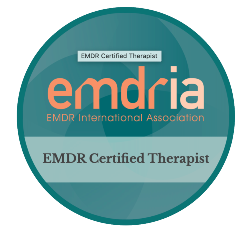EMDR Therapy
How does EMDR work?
There are many hypothses as to how EMDR therapy works as a mode of healing from trauma. Based on SPECT scans of the brain, there are physical improvements in brain structure (based on the areas of the brain that light up in the studies) to indicate a positive impact from EMDR.
Some of the theories that are hypothesized to be impacting the EMDR effects are related to the way EMDR mimics the process that takes place during the REM cycle of sleep, helping the brain to organize events in a way that helps to resolve disturbance. The back and forth eye movements create a calming effect by engaging the parasympathetic nervous system that has a calming effect, thereby relaxing the sympathetic nervous system that is responsible for the flight, fight or freeze response.
Other theories involve the aspect of EMDR therapy that takes place with dual attention during reprocessing. By paying attention to specific memories while simultaneously maintaining awareness of the sensory stimuli, theorists suggest that there is an increase in the prefrontal orbital cortex. This portion of the brain is responsible for higher executive functions which creates greater mindfulness and improved perspective.
There are many more hypotheses about what exactly it is that fosters such rapid resolution of trauma symptoms during EMDR, and the aforementioned theories are just a couple of them. Bottom line is that the EMDR therapy seems to expedite the resolution of trauma in what is usually a shorter duration of therapy.
The process of doing EMDR therapy varies slightly based on client’s circumstances and their history. That said, the bulk of the time, EMDR therapists follow the standard eight phases of EMDR therapy when using this form of treatment.
- Getting history for EMDR: The therapist starts by getting your background. During this phase we are looking at the areas you would like to address with the EMDR therapy and learning more about the foundation of your experiences.
- Preparing for EMDR therapy: During this phase of the therapy, we are teaching you coping skills and building on your strengths and resources. We are preparing you for the EMDR reprocessing so that it progresses most efficiently.
- Setting up the EMDR target: Once we know which issues we would like to address, we will start setting up the “target” (issue that we will focus on) for reprocessing.
- EMDR desensitization:We do the actual reprocessing of the target using eye movements until there is no longer any disturbance associated with it.
- EMDR installation:We will continue to use eye movements after reprocessing the disturbance associated with the memory, but at this point will be focusing on your positive belief and adaptive perspective.
- EMDR body scan: Your therapist will have you bring your attention to your whole body to determine if there is any residual disturbance.
- EMDR closure: Your therapist will help you to integrate the new adaptive perspective into your day to day life.
- EMDR re-evaluation: At subsequent sessions we are re-assessing the treatment effects from the previous session to make sure that they have been sustained or to assess where we need to resume the work.
Related Posts
- What Is Trauma-Informed Care?It is shocking how widespread trauma is, and how devastating its generational impacts can be. Trauma is subjective—some people have a greater capacity for stress than others—and can come in many forms.
- How Does Online Therapy Work?In such a short amount of time so much has changed in our world. As a result, we are all having to explore new ways of doing things. Therapy is no different. Although online therapy…
- Posttraumatic Growth: From Surviving to ThrivingThe pursuit of happiness and thriving is deep-seated in each of us, yet can feel unattainable for some who are struggling to recover from trauma or complex trauma. There are inspiring stories of triumph and…
Call (303) 221-1272 for a 15 minute free initial phone consultation. You may also email us to schedule a time to talk over the phone. We are happy to answer any questions you may have so that you can feel confident starting your path to healing.







